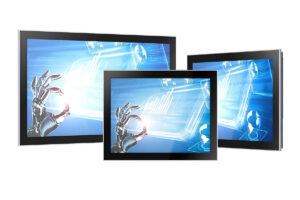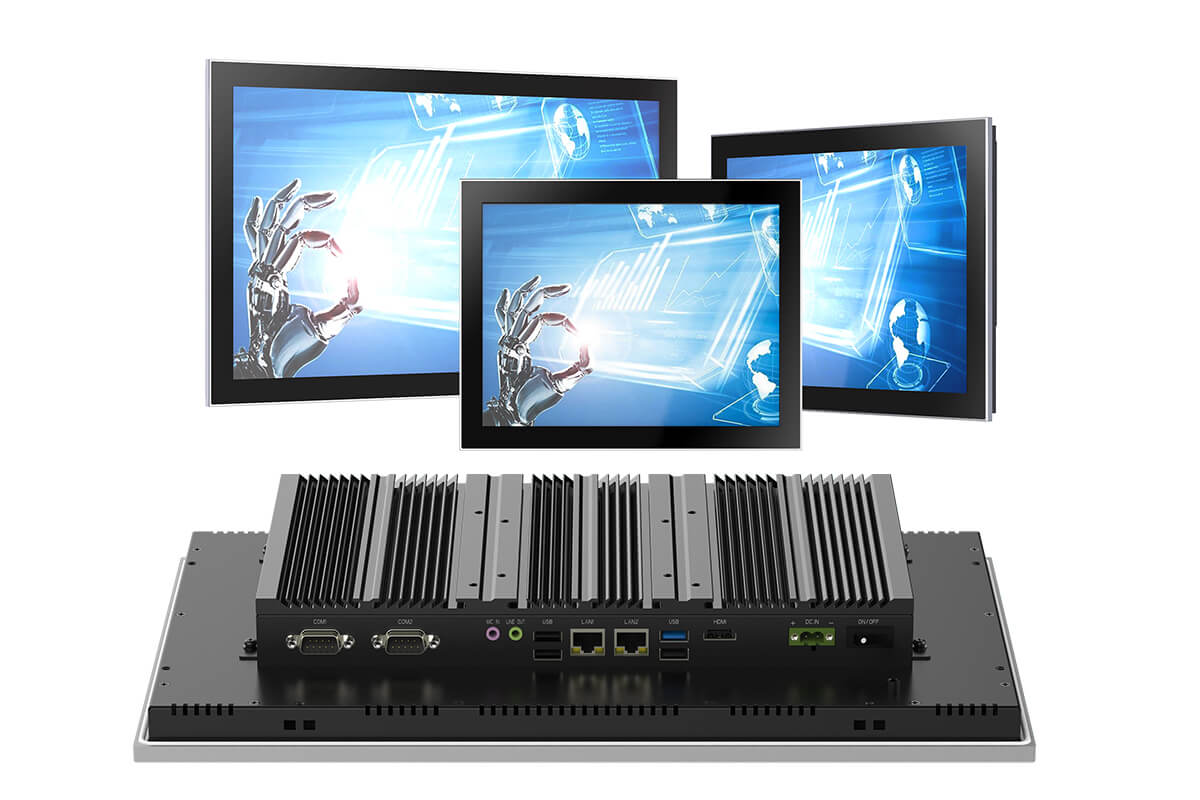Blog
Evolution of Touch Panel PC Systems

Touch Panel PC Systems have become integral components in the realm of modern computing, offering a more interactive and user-friendly experience. These systems represent a fusion of advanced hardware and intuitive touch screen technology, providing users with a dynamic interface for various applications. In this section, we delve into the definition of Touch Panel PC Systems, exploring the fundamental characteristics that distinguish them in the digital landscape.

Introduction
Historical Context and Early Developments:
1. Emergence of Touch Technology:
- Pre-Digital Era: The concept of touch interfaces dates back to the pre-digital era with early experiments and prototypes. However, it wasn’t until the advent of digital technology that touch interfaces began to take shape.
- 1980s-1990s: The first significant strides in touch technology occurred in the 1980s and 1990s. Resistive touch screens, utilizing layers of flexible materials, were among the initial technologies employed in touch-sensitive devices.
- Early Applications: Touch technology found early applications in industries like manufacturing and control systems where the direct manipulation of data on screens proved advantageous.
2. Evolution of Touch Panel PC Systems:
- Resistive to Capacitive Transition: The transition from resistive to capacitive touch technology marked a pivotal moment. Capacitive screens, relying on the electrical properties of the human body, brought about improvements in sensitivity and durability.
- Mobile Devices Pioneering Touch: Mobile devices, particularly smartphones and tablets, played a crucial role in popularizing touch interfaces among consumers. The success of these devices propelled touch technology into the mainstream.
First Generation: Resistive Touch Panels
A. Basic Working Principles:
- Layered Structure:
- Resistive touch panels consist of multiple layers, typically two flexible layers separated by a thin gap. The inner surface of each layer is coated with a resistive material.
- Voltage and Pressure Sensitivity:
- When pressure is applied to the screen, the layers make contact at the touched point. This contact alters the electrical current flow, and the system detects the change in voltage, pinpointing the touched location.
- Coordinate Calculation:
- The system calculates the coordinates of the touch point based on the change in electrical signals. By interpreting the electrical resistance at the intersection point, the system determines the precise location of the touch.
B. Advantages and Limitations:
Advantages:
- Cost-Effective Manufacturing:
- Resistive touch panels are relatively simple to manufacture, making them a cost-effective option compared to some alternative technologies.
- Operability with Various Inputs:
- Resistive panels can register input from various sources, including fingers, styluses, and even gloved hands. This versatility contributed to their initial popularity in diverse environments.
- Durability:
- The layers of resistive touch panels are robust and durable, making them resistant to scratches and other physical damage.
Limitations:
- Lower Transparency and Image Quality:
- The layered structure of resistive panels reduces the transparency of the display, impacting image quality and color accuracy.
- Limited Multi-Touch Capability:
- First-generation resistive touch panels typically lack advanced multi-touch capabilities. They can register only a single point of contact at a time.
- Sensitivity to Pressure:
- Resistive panels rely on pressure for input registration. This sensitivity to pressure can result in inadvertent touches or require a more deliberate touch, affecting user experience.
C. Early Applications and Industries:
- Industrial Control Systems:
- Resistive touch panels found early applications in industrial control systems and Human-Machine Interfaces (HMIs). Their ability to withstand harsh environments and various input types made them suitable for manufacturing and process control.
- Retail Point-of-Sale (POS) Systems:
- The cost-effectiveness and versatility of resistive touch panels made them popular in retail POS systems, where they could handle diverse forms of input, including stylus signatures.
- Public Information Kiosks:
- Resistive touch technology was widely adopted in public information kiosks, providing users with an interactive way to access information in locations such as malls, museums, and transportation hubs.
- Medical Devices:
- Resistive touch panels were integrated into certain medical devices and equipment, where their durability and compatibility with various input methods were advantageous.
- Handheld Devices:
- Some early handheld devices and personal digital assistants (PDAs) featured resistive touch panels, offering users a touch-based interface in a portable form factor.
As we progress through the evolution of touch panel technology, subsequent sections will explore the transition to capacitive touch panels and the advancements that followed in the world of Touch Panel PC Systems.

Second Generation: Capacitive Touch Panels
A. Transition to a New Technology:
- Principle Shift:
- The transition to capacitive touch panels marked a paradigm shift in touch technology. Unlike resistive panels, capacitive panels rely on the electrical properties of the human body for input.
- Electrostatic Fields:
- Capacitive panels feature a glass or transparent conductor surface that holds an electrical charge. When a conductive object, such as a finger, comes into contact with the screen, it disrupts the electrostatic field, triggering touch detection.
- No Pressure Required:
- Unlike resistive panels, capacitive touch panels do not require pressure for input. The mere presence of a conductive object near the screen’s surface is sufficient for touch registration.
B. Improved Sensitivity and Durability:
Improved Sensitivity:
- High Sensitivity to Touch:
- Capacitive touch panels offer higher sensitivity to touch, allowing for more precise and responsive interactions. This increased sensitivity contributes to a more natural and fluid user experience.
- Multi-Touch Capability:
- Capacitive panels introduced advanced multi-touch capabilities, enabling users to perform gestures such as pinch-to-zoom and two-finger scrolling. This further enhanced the versatility of touch interfaces.
Enhanced Durability:
- Durability of Glass Surface:
- Capacitive panels often feature a glass surface, which is more durable and resistant to scratches compared to the layered structure of resistive panels.
- Longevity of Technology:
- The reliance on a solid-state, glass-based design contributes to the longevity of capacitive touch technology, reducing wear and tear over time.
C. Widening Applications in Consumer Electronics:
- Smartphones and Tablets:
- The widespread adoption of capacitive touch panels began with the rise of smartphones and tablets. The technology’s responsiveness and multi-touch capabilities became integral to the user experience on these devices.
- Laptops and Personal Computers:
- Capacitive touch panels found their way into laptops and personal computers, offering users an alternative input method alongside traditional keyboards and mice.
- Interactive Displays and Smart TVs:
- Capacitive touch technology contributed to the development of interactive displays and smart TVs, allowing users to navigate menus and control content with touch gestures.
- Gaming Devices:
- Capacitive touch panels were integrated into gaming devices, including handheld consoles and gaming laptops, providing gamers with responsive touch controls.
- Automotive Touchscreens:
- The automotive industry adopted capacitive touch panels for in-car infotainment systems and touchscreens, enhancing the driver and passenger experience with intuitive controls.
- Wearables and IoT Devices:
- The compact size and sensitivity of capacitive touch panels made them suitable for wearables and various Internet of Things (IoT) devices, enabling touch-based interactions in smaller form factors.
As we explore the evolution of Touch Panel PC Systems, subsequent sections will delve into the advancements in multi-touch technology, interactive displays, and the integration of touch interfaces in diverse industries.
Multi-Touch Technology
A. Introduction and Features:
- Definition of Multi-Touch:
- Multi-touch technology allows a touch panel to recognize and respond to the input of multiple touch points simultaneously. Instead of registering a single touch, these systems can detect and interpret the input of two or more fingers or conductive objects.
- Features of Multi-Touch:
- Gesture Recognition: Multi-touch enables the recognition of gestures, such as pinch-to-zoom, rotate, swipe, and tap, expanding the range of interactions beyond simple touches.
- Simultaneous Input: Users can provide input at multiple points on the screen simultaneously, facilitating more complex and dynamic interactions.
- Pressure Sensitivity: Some multi-touch systems incorporate pressure sensitivity, allowing the device to respond not only to the location of the touch but also to the force applied.
- Enhanced User Interface: Multi-touch enhances the overall user interface by introducing intuitive and natural ways of interacting with digital content.

B. Impact on User Experience:
- Natural Interaction:
- Multi-touch technology creates a more natural and intuitive user experience by mimicking real-world gestures. This leads to a reduction in learning curves, making the technology accessible to a broader range of users.
- Efficient Navigation:
- Multi-touch gestures streamline navigation and manipulation of content. Users can zoom in and out, rotate images, and navigate through applications with fluid and effortless gestures.
- Enhanced Productivity:
- In productivity-oriented applications, such as document editing or graphic design, multi-touch technology enables users to perform tasks more efficiently. For example, manipulating objects or scrolling through content becomes faster and more responsive.
- Collaborative Workspaces:
- Multi-touch screens facilitate collaborative workspaces where multiple users can interact with the same display simultaneously. This is particularly beneficial in educational settings, boardrooms, and creative collaborations.
C. Integration in Mobile Devices and Computing:
- Mobile Devices:
- Multi-touch technology revolutionized the way users interact with mobile devices. Smartphones and tablets, equipped with multi-touch screens, introduced gestures like pinch-to-zoom and swiping, enhancing the overall user experience.
- Tablet Computing:
- Tablets, with their larger touchscreens, greatly benefit from multi-touch capabilities. Users can manipulate digital content, draw, and navigate with gestures, making tablets versatile tools for both work and leisure.
- Laptops and Convertibles:
- The integration of multi-touch screens in laptops and convertible devices adds an extra layer of functionality. Users can switch between traditional keyboard and mouse input and touch interactions based on their preferences and tasks.
- Interactive Displays:
- Interactive displays in classrooms, conference rooms, and public spaces leverage multi-touch technology for collaborative learning and presentations. Multiple users can interact with the content simultaneously, fostering engagement.
- Gaming Consoles:
- Multi-touch screens and interfaces are increasingly integrated into gaming consoles. These systems allow gamers to control characters, navigate menus, and execute in-game actions using intuitive gestures.
- In-Car Infotainment Systems:
- Automotive infotainment systems utilize multi-touch technology to provide drivers and passengers with interactive controls for navigation, media playback, and other features, enhancing the overall driving experience.
As we progress through the exploration of Touch Panel PC Systems, subsequent sections will delve into advancements such as interactive displays, gesture recognition, and the integration of touch interfaces in diverse industries.
Conclusion
As we stand at the intersection of technology and human interaction, Touch Panel PC Systems continue to play a pivotal role in shaping the digital landscape. The journey from resistive touch panels to interactive displays and gesture control reflects not only technological progress but also a commitment to creating more intuitive, accessible, and engaging computing experiences. The ever-evolving nature of these systems ensures that they will remain at the forefront of the digital revolution, influencing how we live, work, and connect in the years to come.